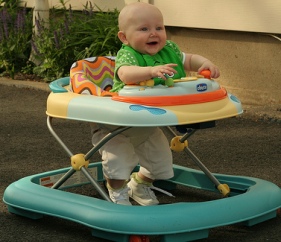By THE NEW YORK TIMES
Q.
D. J. from New York City asks the Consults blog:
I know some people use baby walkers to help
young children learn to walk. Is it true that this may actually be
harmful to developing bones and muscles?
A.
Pediatrician Dr. Alan Greene responds:
It’s so exciting to see a baby take the first
step! When wheeled seats arrived on the scene that would allow babies
to move around with their feet on the floor, parents and babies alike
were delighted. Some parents still use these baby walkers to help their
children learn to walk or to give them some exercise or mobility. Some
use baby walkers almost like pacifiers for the legs: many babies seem
happier when they are propelling themselves across the floor.
And let’s face it, sometimes parents need to
get things done. Sometimes parents use walkers as a baby-sitter, to keep
their baby occupied and entertained so they do other things.
Parents should know that walker use typically delays motor development – and that it delays mental development even more. Beyond this, walker use is dangerous.
Back in 1994, when baby walkers were still
extremely popular in the United States, the Consumer Products Safety
Commission declared that baby walkers were responsible for more injuries
than any other children’s product. The types of injuries included head
injuries, broken bones, broken teeth, burns, entrapment of fingers and
even amputations or death.
Walkers allow mobility beyond a baby’s natural capability,
and faster than a parent’s reaction time. Most of the injuries involve
falls down stairs, but injuries can also come, for instance, from
allowing reach to hot, heavy or poisonous objects. Today’s walkers are
safer, but they are still hazardous – and of no benefit to the baby.
Canada banned baby walkers in 2004. Possession of a baby walker can lead to fines up to $100,000 or six months in jail. But in some countries, more than 75 percent of babies still use walkers– and the injuries continue.
Sometime in the second half of the first
year, healthy babies develop a strong urge to move across the floor. At
first, this is a struggle for them as they work their arms and legs,
stretching, rolling, scooting or crawling. They find delight in
accomplishment as they achieve their goal of a toy out of reach. Later,
the focus of their work will turn to pulling themselves upright.
Babies who use a walker skip some of this
magnificent developmental journey. With their toes in an unnatural
position, they glide across the floor with ease, moving upright before
their time.
What’s the outcome?
Besides the added dangers of moving faster, falling farther and reaching higher,
babies who use walkers learn to crawl, stand and walk later than they
would have otherwise, and continue to show delayed motor development for
months after they have learned to walk. The delay seems to be a little
more than three days for every 24 hours of total walker use.
But the biggest delays – and the biggest
surprise to many parents – are delays in mental development and lower
scores on mental developmental testing, still present 10 months after
initial walker use.
Stationary activity centers for babies can
provide many of the benefits parents are looking for from walkers,
without the serious problems.
I’m so glad for your question. Almost every
week I still come across a parent who is using a walker in the mistaken
belief that it will benefit their children, unaware of the risks and the costs of walker use.
Alan Greene, M.D., is the founder of the Web site DrGreene.com and the author of “From First Kicks to First Steps.”
Article retrieved from: http://consults.blogs.nytimes.com/2010/02/22/the-dangers-of-baby-walkers/?_php=true&_type=blogs&_r=0
Image retrieved from: http://www.newbornbabyzone.com/wp-content/uploads/2008/08/baby-walker.jpg

0 comments:
Post a Comment